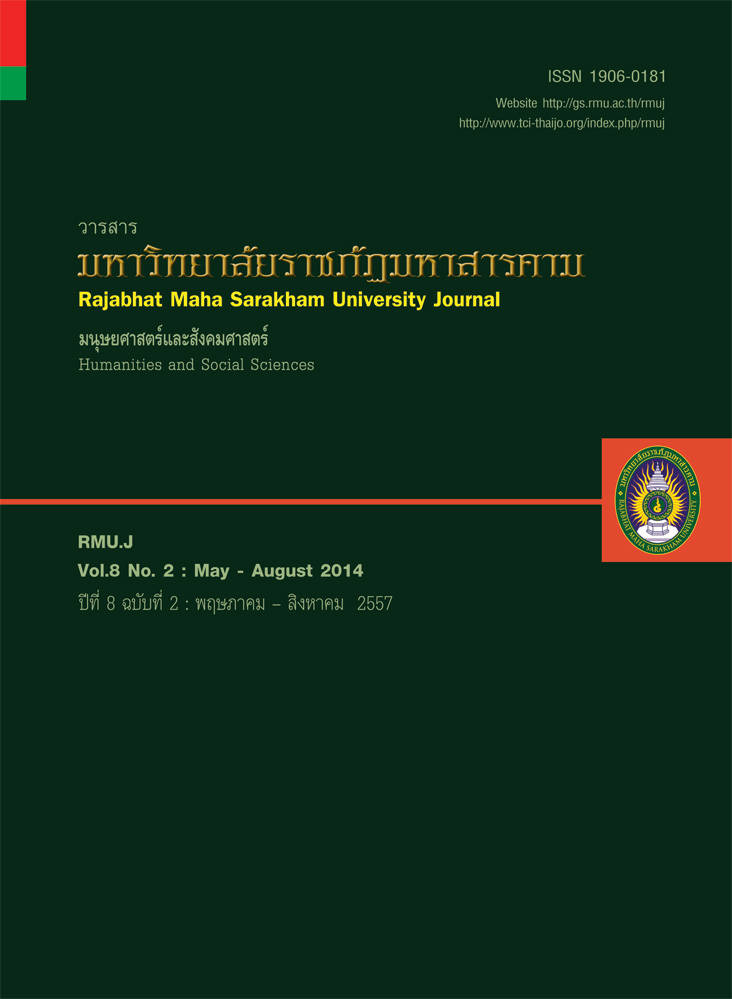รูปแบบการสอนที่ใช้การเล่าเรื่องและการเขียนแผนที่ความคิดเพื่อพัฒนาความสามารถ การเขียนเรื่องราวของนักเรียนระดับชั้นประถมศึกษาปีที่ 6 An Instructional Model Using Storytelling and Mind Mapping to Enhance English Story Writing Ability of Grade 6th Students
Main Article Content
บทคัดย่อ
การวิจัยในครั้งนี้ผู้วิจัยได้สร้างรูปแบบการสอนที่ใช้การเล่าเรื่องและการเขียนแผนที่ความคิดขึ้นแล้วพัฒนาตามกระบวนการ
วิจัยเชิงปฏิบัติการ โดยมีวัตถุประสงค์เพื่อพัฒนารูปแบบการสอนและศึกษาผลการเรียนรู้ด้วยรูปแบบการสอนที่สร้างขึ้น กลุ่มตัวอย่าง
เป็นนักเรียนชั้นประถมศึกษาปีที่ 6 ภาคเรียนที่ 1 ปีการศึกษา 2554 โรงเรียนบ้านห้างหว้า (คุรุรัฐประชาสรรค์) จังหวัดร้อยเอ็ด จำนวน
36 คน ได้มาโดยการสุ่มอย่างง่าย เครื่องมือที่ใช้ในการวิจัยได้แก่ 1)เครื่องมือที่ใช้ในการปฏิบัติการวิจัย 2) เครื่องมือที่ใช้สะท้อนผลการ
ปฏิบัติ และ 3) เครื่องมือที่ใช้ในการประเมินประสิทธิภาพของรูปแบบการสอน วิเคราะห์ข้อมูลทั้งเชิงปริมาณและเชิงคุณภาพ ใช้เกณฑ์
ประสิทธิภาพ E1/ E2 เปรียบเทียบเกณฑ์มาตรฐาน (ร้อยละ 60) สถิติ t-test (Dependent samples) หาค่าดัชนีประสิทธิผล (E.I.)
ค่าเฉลี่ยและส่วนเบี่ยงเบนมาตรฐาน ผลการวิจัยพบว่า
รูปแบบการสอนที่สร้างขึ้นมีประสิทธิภาพ 75.80/76.11 ความสามารถการเขียนเรื่องราวเฉลี่ยร้อยละ 76.11 ผ่านเกณฑ์ร้อยละ
100 ของกลุ่มตัวอย่าง ความสามารถการเขียนเรื่องราวหลังเรียนสูงกว่าก่อนเรียนอย่างมีนัยสำคัญทางสถิติที่ระดับ .05 ความก้าวหน้า
การเขียนเรื่องราวเพิ่มขึ้นร้อยละ 69.71 ความพึงพอใจของผู้เรียนเฉลี่ยเท่ากับ 4.52 อยู่ในระดับมากที่สุด รูปแบบการสอนที่พัฒนาขึ้นจึงเหมาะสมในการนำไปใช้ต่อไป
The research was constructed an instructional model using storytelling and mind mapping which was
developed by action research process. The objectives were to develop the teaching model and study the
learning outcomes of learning via model construction. The subjects used in the research were 36 grade 6th
students, selected through simple random sampling technique in the first semester of the academic year
2011 at Ban Hang Wah (Kururatpachasan) School, Roi-Et province. The instruments used in the research
consisted of: 1) instruments for action research, 2) instruments for reflection, and 3) instruments for evaluation
of the effectiveness of instructional model. The data were analyzed both qualitative and quantitative methods
using the criteria to verify E1/E2 compared with standard criterion (60%). The statistics used in the research were t-test dependent samples, mean and standard deviation.
The research revealed that the effectiveness of the instructional model was 75.80/76.11 as determined
by the setting criteria, students’ writing ability in English story after the treatment showed 76.11% passed the
criteria 100% of subjects, the students’ writing ability after learning was higher than before learning with
statistically significant at .05 level. The students’ progress in writing ability the English story revealed their
outstanding performance at 69.71 percent. The students’ satisfaction towards the developed instructional
model was at the highest level ( = 4.52). The developed instructional model could be appropriate for the
implementation.
Article Details
1. บทความที่ลงตีพิมพ์ทุกเรื่องได้รับการตรวจทางวิชาการโดยผู้ประเมินอิสระ ผู้ทรงคุณวุฒิ (Peer Review) สาขาที่เกี่ยวข้อง อย่างน้อย 3 ท่าน ในรูปแบบ Double blind review
2. ข้อคิดเห็นใด ๆ ของบทความที่ลงตีพิมพ์ในวารสารมหาวิทยาลัยราชภัฏมหาสารคาม นี้เป็นของผู้เขียน คณะผู้จัดทำวารสารไม่จำเป็นต้องเห็นด้วย
3. กองบรรณาธิการวารสารมหาวิทยาลัยราชภัฏมหาสารคาม ไม่สงวนสิทธิ์การคัดลอกแต่ให้อ้างอิงแสดงที่มา


